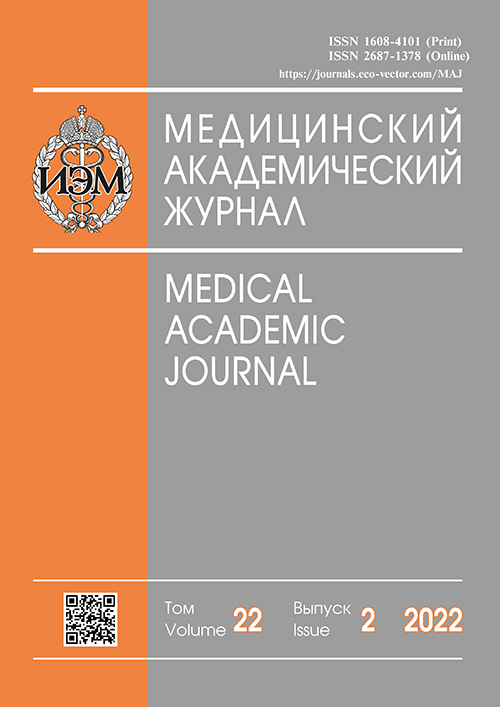Альфакоронавирусы из фекалий летучих мышей, пойманных на территории Москвы и Ростова-на-Дону в 2021 г.
- Авторы: Корнеенко Е.В.1, Самойлов А.Е.1,2, Артюшин И.В.3, Юзефович А.П.3, Долотова С.М.4, Ключникова Е.О.2, Сбарцалья В.А.2, Гладких А.С.2, Дедков В.Г.2, Сперанская А.С.1,3
-
Учреждения:
- Научно-исследовательский институт системной биологии и медицины
- Санкт-Петербургский научно-исследовательский институт эпидемиологии и микробиологии им. Пастера Роспотребнадзора
- Московский государственный университет им. Н.В. Ломоносова
- Московский физико-технический институт (национальный исследовательский университет)
- Выпуск: Том 22, № 2 (2022)
- Страницы: 203-208
- Раздел: Материалы конференции
- Статья опубликована: 06.11.2022
- URL: https://journals.eco-vector.com/MAJ/article/view/108718
- DOI: https://doi.org/10.17816/MAJ108718
- ID: 108718
Цитировать
Полный текст
Аннотация
Обоснование. Рукокрылые — своего рода резервуар большого количества вирусов, включая коронавирусы. Именно поэтому мониторинг коронавирусов в летучих мышах — актуальная на сегодняшний день задача.
Цель исследования — поиск новых вирусов семейств Coronaviridae, носители которых — летучие мыши, обитающие на территории Европейской части России.
Материалы и методы. Для поиска вирусов в фекалиях летучих мышей, пойманных в Москве, Московской области (Солнечногорск, Видное, Троицк, Мытищи), Калуге, Ростове-на-Дону, Йошкар-Оле в 2021 г., применяли методику выявления вирусов с помощью амплификации фрагментов геномов вирусов (участка RdRp, кодирующего репликазу), с последующим проведением высокопроизводительного секвенирования этих фрагментов на платформе Illumina (MiSeq, USA).
Результаты. Установлены последовательности фрагментов генов RdRp как минимум двух разных коронавирусов в четырех особях летучих мышей трех разных видов.
Заключение. Наши результаты демонстрируют наличие вирусов рода Alphacoronavirus в четырех из 17 особей. Положительные на коронавирус четыре летучие мыши, пойманные в 2021 г. на территории Москвы, Московской области и Ростова-на-Дону, оказались носителями разных изолятов одного альфакоронавируса, что позволяет предположить возможность передачи этого вируса между животными разных видов. В одной особи обнаружены фрагменты генома двух разных альфакоронавирусов.
Полный текст
Об авторах
Елена Васильевна Корнеенко
Научно-исследовательский институт системной биологии и медицины
Автор, ответственный за переписку.
Email: lenakorneenko0@gmail.com
ORCID iD: 0000-0001-5877-0719
научный сотрудник
Россия, МоскваАндрей Евгеньевич Самойлов
Научно-исследовательский институт системной биологии и медицины; Санкт-Петербургский научно-исследовательский институт эпидемиологии и микробиологии им. Пастера Роспотребнадзора
Email: andrei.samoilov@gmail.com
ORCID iD: 0000-0001-8284-3164
Scopus Author ID: 57193001010
научный сотрудник
Россия, Москва; Санкт-ПетербургИлья Витальевич Артюшин
Московский государственный университет им. Н.В. Ломоносова
Email: sometyx@gmail.com
ORCID iD: 0000-0002-4911-3677
Scopus Author ID: 35098142000
ResearcherId: J-6941-2018
канд. биол. наук, научный сотрудник
Россия, МоскваАлександр Павлович Юзефович
Московский государственный университет им. Н.В. Ломоносова
Email: yuzefovich2015elf@gmail.com
младший научный сотрудник
Россия, МоскваСофья Матвеевна Долотова
Московский физико-технический институт (национальный исследовательский университет)
Email: dolotova.sm@phystech.edu
студентка
Россия, Долгопрудный, МоскваЕкатерина Олеговна Ключникова
Санкт-Петербургский научно-исследовательский институт эпидемиологии и микробиологии им. Пастера Роспотребнадзора
Email: Ekaterina.ibg@gmail.com
канд. биол. наук, младший научный сотрудник
Россия, Санкт-ПетербургВалерия Александровна Сбарцалья
Санкт-Петербургский научно-исследовательский институт эпидемиологии и микробиологии им. Пастера Роспотребнадзора
Email: Sbarzaglia.valeriya@gmail.com
канд. биол. наук, младший научный сотрудник
Россия, Санкт-ПетербургАнна Сергеевна Гладких
Санкт-Петербургский научно-исследовательский институт эпидемиологии и микробиологии им. Пастера Роспотребнадзора
Email: angladkikh@gmail.com
ORCID iD: 0000-0001-6759-1907
ResearcherId: G-6045-2015
канд. биол. наук, старший научный сотрудник
Россия, Санкт-ПетербургВладимир Георгиевич Дедков
Санкт-Петербургский научно-исследовательский институт эпидемиологии и микробиологии им. Пастера Роспотребнадзора
Email: vgdedkov@gmail.com
канд. мед. наук, заместитель директора по научной работе
Россия, Санкт-ПетербургАнна Сергеевна Сперанская
Научно-исследовательский институт системной биологии и медицины; Московский государственный университет им. Н.В. Ломоносова
Email: hanna.s.939@gmail.com
ORCID iD: 0000-0001-6326-1249
канд. биол. наук, старший научный сотрудник
Россия, Москва; МоскваСписок литературы
- Moratelli R., Calisher C.H. Bats and zoonotic viruses: Can we confidently link bats with emerging deadly viruses? // Mem. Inst. Oswaldo Cruz. 2015. Vol. 110, No. 1. P. 1–22. doi: 10.1590/0074-02760150048
- Shi Z.L. Emerging infectious diseases associated with bat viruses // Sci. China Life Sci. 2013. Vol. 56, No. 8. P. 678–682. doi: 10.1007/s11427-013-4517-x
- Smith I., Wang L.F. Bats and their virome: An important source of emerging viruses capable of infecting humans // Curr. Opin. Virol. 2013. Vol. 3, No. 1. P. 84–91. doi: 10.1016/j.coviro.2012.11.006
- Woo P.C., Lau S.K., Lam C.S. et al. Discovery of seven novel Mammalian and avian coronaviruses in the genus deltacoronavirus supports bat coronaviruses as the gene source of alphacoronavirus and betacoronavirus and avian coronaviruses as the gene source of gammacoronavirus and deltacoronavirus // J. Virol. 2012. Vol. 86, No. 7. P. 3996–4008. doi: 10.1128/JVI.06540-11
- Letko M., Seifert S.N., Olival K.J. et al. Bat-borne virus diversity, spillover and emergence // Nat. Rev. Microbiol. 2020. Vol. 18, No. 8. P. 461–471. doi: 10.1038/s41579-020-0394-z
- Kohl C., Kurth A. European bats as carriers of viruses with zoonotic potential // Viruses. 2014. Vol. 6, No. 8. P. 3110–3128. doi: 10.3390/v6083110
- Phelps K.L., Hamel L., Alhmoud N. et al. Bat research networks and viral surveillance: Gaps and opportunities in western Asia // Viruses. 2019. Vol. 11, No. 3. P. 240. doi: 10.3390/v11030240
- Alkhovsky S., Lenshin S., Romashin A. et al. SARS-like coronaviruses in horseshoe bats (Rhinolophus spp.) in Russia, 2020 // Viruses. 2022. Vol. 14, No. 1. P. 113. doi: 10.3390/v14010113
- Львов Д.К., Альховский С.В. Истоки пандемии COVID-19: экология и генетика коронавирусов (Betacoronavirus: Coronaviridae) SARS-CoV, SARS-CoV-2 (подрод Sarbecovirus), MERS-CoV (подрод Merbecovirus) // Вопросы вирусологии. 2020. Т. 65, № 2. С. 62–70. doi: 10.36233/0507-4088-2020-65-2-62-70
- Da Silva Filho L.V., Zerbinati R.M., Tateno A.F. et al. The differential clinical impact of human coronavirus species in children with cystic fibrosis // J. Infect. Dis. 2012. Vol. 206, No. 3. P. 384–388. doi: 10.1093/infdis/jis274
- Safonova M.V., Shchelkanov M.Y., Khafizov K. et al. Sequencing and genetic characterization of two strains Paramushir virus obtained from the Tyuleniy Island in the Okhotsk Sea (2015) // Ticks Tick Borne Dis. 2019. Vol. 10, No. 2. P. 269–279. doi: 10.1016/j.ttbdis.2018.11.004
- Moreno A., Lelli D., de Sabato L. et al. Detection and full genome characterization of two beta CoV viruses related to Middle East respiratory syndrome from bats in Italy // Virol. J. 2017. Vol. 14, No. 1. P. 239. doi: 10.1186/s12985-017-0907-1
- Alcalde J.T., Jiménez M., Brila I. et al. Transcontinental 2200 km migration of a Nathusius’ pipistrelle (Pipistrellus nathusii) across Europe // Mammalia. 2021. Vol. 85, No. 2. P. 161–163. doi: 10.1515/mammalia-2020-0069
- Vasenkov D., Desmet J.-F., Popov I., Sidorchuk N. et al. Bats can migrate farther than it was previously known: a new longest migration record by Nathusius’ pipistrelle Pipistrellus nathusii (Chiroptera: Vespertilionidae) // Mammalia. 2022. doi: 10.1515/mammalia-2021-0139
Дополнительные файлы






